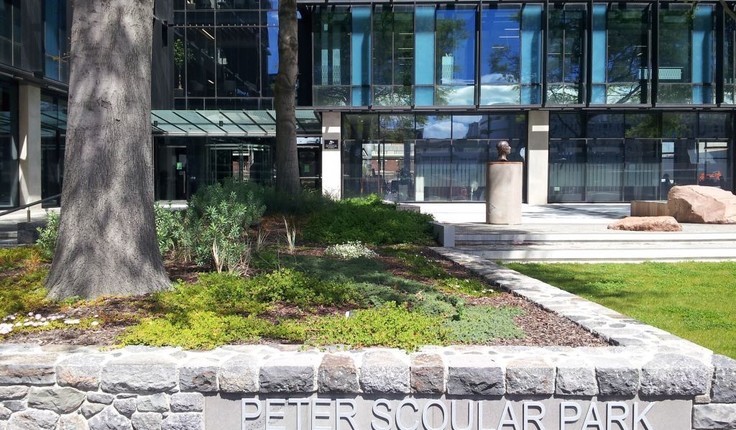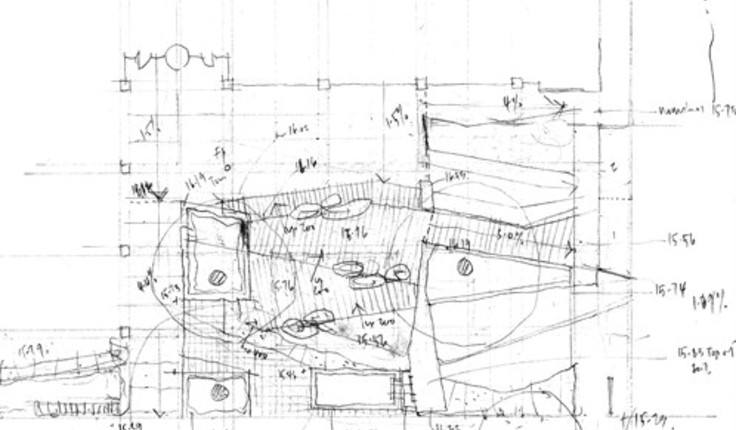News
Instant Pocket Park
Posted 30 11 2016
in News

A green island in a sea of earthquake demolition has been brought back to life.
Typically, pocket parks take years and years before they reach their full potential, as a relaxed leafy retreat nestled within a busy urban environment. Often created on small vacant building lots, or irregular shaped land leftover from urban development, pocket parks tend to come second to the large buildings that first surround them. Often it's not until the planting matures and a lively community establishes, that a pocket park truly becomes an important refuge for meeting people, lunch breaks, and small events.
Peter Scoular Park is different. Here, a redundant pocket park, left behind by the surrounding earthquake demolition, has instantly become a vibrant place, refurbished and reinstated as the gateway (and centre piece) to the new Environment Canterbury (ECAN) building in central Christchurch.
Earlier this year, ECAN moved into its new $52 million building at 200 Tuam Street, marking the first time in 5 years that their 450 staff has been together under one roof, since the 2011 Christchurch earthquakes, decommissioned their former building on Kilmore Street.
Twelve years on from designing a roof garden civic space for the former ECAN building on Kilmore street, Rough and Milne Landscape Architects (RMLA) were re-engaged to work on the new ECAN building on Tuam Street, including its integration with Peter Scoular Park.
The design vision was to retain key features of the original Peter Scoular Park; complement the architecture of the new building; and develop a microcosm of the diverse range of flora and geology throughout the Canterbury region.
Retention of Existing Features
Like many pocket parks, Peter Scoular Park doubles as an historic monument. The park is dedicated to Peter Scoular, a deputy general manager and city engineer for the Christchurch City Council (CCC), that was (like this project) involved in redevelopment city projects during the 1970's and early 1980's.

Originally, Peter Scoular Park was a small block of land (342m²) adjacent to a large car park across the road from the former Christchurch City Council offices on Tuam Street. It included an assortment of 1980's style red brick raised planters and a central raised lawn. A number of pin oak trees were planted within the raised planters, and over the past 35 years, these have grown into large trees.
The retention of 4 mature pin oak trees within the pocket park was a key consideration of the project and involved careful planning of the site levels, so the trees could be maintained at their current level above ground. RMLA collaborated with arborists to establish a management plan to protect the trees during construction and ensure a rigorous watering programme was in place during the hot summer norwesters, when the roots were exposed.
The central raised lawn within the former Peter Scoular Park was retained as a feature within the new design, but increased in size to provide visual relief from the surrounding hardstand paving.
As the original signage had been stolen (perhaps now a relic in someone's living room) new stainless signage was integrated into the basalt wall interfacing with the street and a plaque was installed to better commemorate Peter Scoular.
Accentuate New Building
The broad terraces, steps, raised planters and decking gently rise from street level to the floor level, and together provide a plinth for the building when viewed from Tuam Street. Peter Scoular Park remains assessable from the street and provides a gateway to the main entrance to the new building. The subdued earthy design materials, including basalt stone, exposed aggregate concrete, hardwood timber and stainless steel, work well together and complement the new building.
Microcosm of Flora and Geology
A feature of the project is the eight large boulders arranged in a Matariki star constellation and their juxtaposition with the decking, paving and lawn. Each boulder was donated by one of the Ngai Tahu rununga, and reveals the broad range of geology within the Canterbury region.
Native vegetation, found within the Canterbury region, is showcased within 2 large raised planters defining the spatial layout of the park. Symbolically, the planters represent slices of varying lowland planting found within the region.
The refurbishment of Peter Scoular Park and return of a significant workforce to the city provides a boost to Christchurch's inner city and catalyst for further urban development and renewed city vibrancy as Christchurch city redefines itself.
Share
19 Dec
Christmas break 2025

see you from 12 January
As we wrap up another big year, we’re taking a moment to pause, breathe, and enjoy a well-earned break. Meri …
18 Dec
President’s update

December 2025
Earlier this month I attended the Ngā Aho Māori Design Professionals Wānanga-ā-Tau at Te Aranga Marae in Flaxmere. Tuia Pito …
18 Dec
Awards 2026 update

An update as we warm up for the 2026 Awards kaupapa. Submissions will open in March and will run for …
Events calendar
Full 2025 calendar